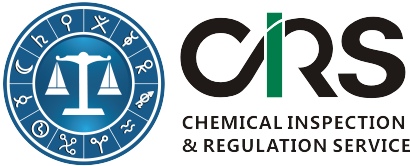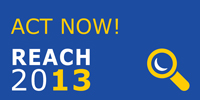
REACH Guidance for Importers
Chemicals and articles are subject to different provisions under REACH. Chemicals generally require REACH registration and SDS. Articles require SVHC disclosure and REACH-restricted substances screening.
If you import chemicals to EU, you will have two choices towards REACH compliance: do your own registration or buy products from REACH compliant suppliers. Please find below a few tips to guide you and help you achieve REACH compliance:
Tip 1. Contact the Only Representative of your suppliers and get your goods certified (sample in download section).
OECD has summarized typical REACH offences [pdf] and penalties [pdf] of EU member states. To avoid penalties, EU importers are recommended to contact the only representative of your suppliers and get the imported goods certified. Based on Keller and Heckman LLP’s suggestion:
“there are many practical questions associated with documenting compliance at the point of entry of goods into the Customs territory of the European Union (EU), particularly with respect to valid pre-registrations, whether the substances are exempt or not from registration, whether the pre-registration obligation was taken over by the importer, the only representative of the exporter, or the only representative of the exporter's supplier and whether the quantities imported have exceeded the tonnage band registered.
The U.S. has in place a simple and effective system for ensuring compliance of imported goods. Under Section 13 of the Toxic Substances Control Act (TSCA), the importer must certify at the point of entry that the goods either are not subject to TSCA, or are subject to TSCA and in compliance. The certification mechanism serves to ensure that importers carefully review the legal status of the goods they order from overseas suppliers.
A similar certification mechanism would be useful if implemented in the EU. Requiring importers to certify will ensure that importers take their responsibilities seriously even if the registration obligation is being carried by the only representative of the foreign supplier. Importer responsibility is fully consistent with Article 5 of REACH and makes a great deal of sense.”
You are recommended to get your goods certified by applying for REACH tonnage coverage certificate for your imports from CIRS. CIRS has adapted its REACH certificate according to the HSA’s suggestion [sample certificate,498kB]. The certificate is issued free of charge and is a useful tool for CIRS’s to record customers sold to and quantities imported.
All certificates will be stored in a reliable and secure REACH Compliance User Management System. You shall also request REACH compliant SDS for substances or mixtures classified as hazardous.
- > Application Form for REACH Certificate[doc, 37KB]
Since the Dutch Environment Ministry (VROM) EU found out many bogus ORs or mailbox ORs in March, the OR inspection has become an integral part of REACH enforcement. EU importers are advised to double check the credentials of ORs with the non-EEA manufacturers that hired them. If they are found to be illegitimate, then importers will need to request their suppliers to change OR or find another legitimate supplier or prepare to register the substances themselves.
Tip 2. If necessary, you can do your own registration:
If your suppliers choose not to complete registration, it is possible for you to register your products by yourself. The registration fee imposed by ECHA is tonnage and company-size specific and as such, SME’s are charged lower fees to engage in the registration process for their substances.
As the 2010 registration deadline approaches, more prices for letters of access are published and the registration costs of many substances have become very clear. It might not be as expensive as you think to complete the registration process for your substances.
CIRS can provide you with a free estimation of the total cost of registering your substances and help you complete registration at the most competitive price in the market. CIRS has pre-registered over 10,000 chemicals and registered over 50 chemicals to date.
For more information about the REACH registration process and REACH registration costs, please click here or contact us.
Tip 3. Source REACH registered chemicals and suppliers:
CIRS has pre-registered over 10,000 substances on behalf of over 2,400 non-EU chemical manufacturers and is expected to acquire at least 200 registration numbers in 2010. So if you wish to identify REACH compliant suppliers and source REACH registered chemicals, please contact us and we can help you with this.
Note: We only recommend REACH compliant suppliers and help companies who have chosen us as service providers to promote their products as value-added services. We do not sell chemicals. This recommendation is free of charge.
Tip 4. Remember to request REACH compliant SDS
REACH has mandated what information should and could be included in each section of the SDS. Since REACH took into force in 2007, SDS shall be updated accordingly and meet the requirements of REACH regulation.
Importers shall always remember to request REACH compliant SDS or prepare their own SDS.
Tip 5. C&L notification – the first step towards CLP compliance
CLP stands for the Regulation (EC) No 1272/2008 on the Classification, Labeling and Packaging of substances and mixtures. CLP introduces the United Nations globally harmonized system (UN GHS) for classification and labeling of chemicals into Europe. CLP entered into force on 20 Jan 2009.
CLP requires that information on substance identity and classification and labelling (“C&L”) of a substance should be notified to ECHA, in a process known as “C&L Notification”. ECHA will include this information in a database, called the Classification and Labelling Inventory.
EU importer of a substance that is subject to registration under REACH or EU importer of a substance that is classified as hazardous irrespective of the quantity shall submit C&L notification to ECHA before 3 Jan 2011 if the importer places the substance on EU market before 1 Dec 2011. If you missed this deadline, you shall notify without any delay.
The most urgent thing for importers to do at the moment is to submit C&L notifications to ECHA. Our recommendation to EU importers is that they shall submit their own C&L notifications as the first choice. If you do not know how to submit C&L notifications, please contact us to help you fulfill your obligations under CLP. It is cheap and easy to do so.
If you import articles (toys, electronics, textiles, etc) to the EU, you shall identify possible Substances of Very High Concern (SVHC) and REACH restricted substances in your products. If your products do not contain SVHC and REACH restricted substances above the threshold limits of REACH, your products are compliant with REACH.
If your products do contain any SVHC and restricted substances above the threshold limits, you need to identify which list the hazardous substances belong to (SVHC candidate list or REACH restriction list or Authorization list) and adopt the following measures to achieve REACH compliance:
- Notification: Submit notification to European Chemical Agency (ECHA) if any the SVHC on candidate list present in an article has a concentration above 0.1% (w/w) and the total amount of the SVHC exceeds 1 tonne per annum per producer or importer. The SVHC candidate list will be regularly updated from time to time.
- Communication Requirement: If any SVHC on candidate list is present in your product with a concentration above 0.1% (w/w), you are obliged to inform the recipients of the article along the supply chain about the chemical name(s) and how the article can be safely used. REACH further requires this information be made available within 45 days upon consumer request.;
- Restriction: Article suppliers not only need to comply with the requirements of SVHC, they also need to comply with the requirements of REACH Restriction. Some candidate SVHCs(for example, anthracene) are also on REACH restricted substances list (XVII of REACH)。They also need to ensure that their products do not contain other REACH restricted substances above threshold limits.
- Authorization: Priority SVHCs on the candidate list will be included in the Annex XIV of REACH (the "Authorization List"). Those SVHCs will not be allowed to be used, placed on the market or imported into the EU after a date to be set unless the company is granted an authorization.
It is recommended that you get your goods certified and keep all records. The most reliable way to identify those hazardous substances is through laboratory testing. You can carry out testing by yourselves or ask your suppliers to do it.
CIRS can carry out an assessment for you or your suppliers, in accordance with your specific industry to choose which items need to be tested, thus improving the efficiency of your testing strategy and saving money on unnecessary testing. Finally, we can supply you with a series of tailor-made ’Assessment Reports ‘ to meet your various requirements.
We provide one-stop REACH compliance solutions for article suppliers and importers. CIRS's certified lab in China provides full range of hazardous substances testing services. We also provide consultancy services such as SVHC notification and application for authorization. Please don't hesitate to contact us or recommend us to your suppliers if you need our assistance.
Contact
- Europe Office
Unit 1 Ardee Business Park, Hale Street, Ardee, Co. Louth, Ireland
Tel : +353 41 9806 916 | Fax : +353 41 9806 999
Email: service@cirs-reach.com
Latest Event
Downloads
- REACH Tonnage Coverage Certificate Application Form [doc,70KB]
- Application Form for C&L Notification, Label and SDS[word,131KB]
- Sample REACH Certificate of Compliance[pdf,439KB]
- Practical CLP Compliance Advice for EU Importers[pdf, 280KB]
- How to Use REACH Registration Numbers? [pdf,163KB)
- Common REACH Offences[pdf,332KB]
- Common REACH Penalties[pdf,253KB]


_will_be_held_in_Shanghai.jpg)
